|
Nancy Brashear and Carolyn Angus Here are some of our favorite international picture books with English translations published in the U.S. this year. These books are good choices for sharing with children at all grade levels not only to enjoy as stories but also to encourage discussion about other languages and cultures and to introduce writers and artists from around the world. 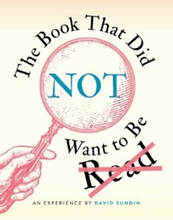 The Book That Did Not Want to Be Read. David Sundin. Trans. by B. J. Woodstein. (2022). Simon & Schuster. “Once upon a time, there was a child who couldn’t fall asleep.” The solution? An adult reads a book the child chooses—unfortunately one that does not want to be read. This interactive book will have children laughing as it speaks directly to the reader and keeps morphing. Pages fill with nonsensical text and weird illustrations. The book grows wings and attempts to fly away. The text shrinks and enlarges, and a rabbit appears. THE END arrives with a warning to not turn the page, but of course they do. The page is on fire. Flames out, random words disappear, and the As change into Os (“WOTCH OUT FOR THE OLLIGOTOR …”), and it is THE END, again. Or is it? NO! The words scramble, turn into a rectangle, and spin before the book finally ends. “SWEET DREAMS.” Warning: This book is a challenge to read aloud and requires some gymnastic moves on the part of the reader. David Sundin lives in Sweden. (PreK Up) —NB 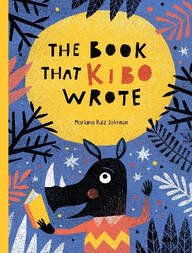 The Book That Kibo Wrote. Mariana Ruiz Johnson. Trans. by Lawrence Schimel. (2022). Eerdmans. Kibo (a black rhino) writes about his home on the savanna every evening. His friend Naki (a crane) sews the pages into a book and drops it into a corner of a city across the sea where Camilo (a lion) finds it. After reading the story that reminds him of his first home, the savanna, Camilo gives the book to his friend Simon (a rabbit), who is inspired by reading it to play his guitar and sing about distant and unknown lands. Simon passes the book on to Valentina (a hen) to read on a plane trip to the North Pole. She leaves the book with her cousin Nanuk (a polar bear), whose heart is warmed by reading the book that Kibo wrote while the whales sing beneath the ice at his feet. Mariana Ruiz Johnson’s colorful illustrations, inspired by folk art, complement her engaging story about how a good book will find readers wherever they live. Mariana Ruiz Johnson lives in Argentina. (PreK Up) --NB 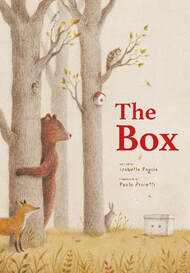 The Box. Isabella Paglia. Trans. by Laura Watkinson. Illus. by Paolo Proietti. (2022). Eerdmans. Fox and Hare discover a mysterious box with two holes cut in the side. When it moves, they shout, “Welcome to the forest!” and “Come on! Come on out!” The response is “Noooooo!” Joined by Bear, Squirrel, and Owl, they try to coax whatever is inside the box out with entertainment and then a party the next day, with no luck. On the third day, they shelter the box in Bear’s den during a rainstorm and are surprised (as will readers be) when the box shakes open, and a colorful parrot squawks, “Thank you so much, everyone, for waiting for me.” With a playful text and softly colored illustrations created with pastel, chalk, and watercolor paint, The Box offers a gentle lesson on kindness and patience in welcoming someone new to your group of friends. Isabella Paglia lives in Italy; Paola Proietti lives in Italy. (PreK Up) —CA 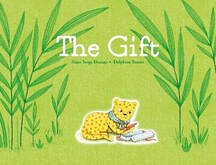 The Gift. Alain Serge Dzotap. Trans. by Eerdmans. Illus. by Delphine Renon. (2022). Eerdmans. Leo, a young cheetah, receives a very special birthday gift, a pen, from his father, who says, “It has all sorts of beautiful things in it.” He promises to show them to him later, but Leo can’t wait. His sister shakes out a few drops of ink. Coco-Tembo, a hen, scoffs at the pen’s tiny size. Super-Zombo, a giraffe, thinks it is a broken flute. Finally, Leo turns to his mother. Paw on paw, she helps him write his name and lots of other words, and on his own, Leo discovers the magic of drawing. “Soon the whole world is coming out of his pen!” Upon his return, Papa admires Leo’s pictures of giraffes, birds, boats, and cheetahs. Delphine Renon’s delightful colored pencil-and-ink drawings complement Alain Serge Dzotap’s story of Leo’s discovery of the power of the pen. Alain Serge Dzotap lives in Cameroon; Delphine Renon lives in France. (PreK-Gr 2) —NB 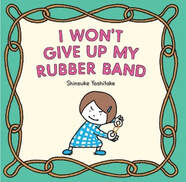 I Won’t Give Up My Rubber Band. Shinsuke Yoshitake. Trans. by Sofiane Kohen. (2022). Chronicle. A young girl finds a special thing to call her own, a rubber band. It belongs to only her. It is not a hand-me-down, and she does not have to share it. She imagines herself doing wonderful things with her rubber band now and in the future like bathing and sleeping with it, wearing it as a fashion statement, bundling future love letters with it, using it to save the world from aliens, and, maybe, tying it to her future soul mate’s rubber band. She declares that she will never give her treasure up, but as she dreams of possibilities, she tugs and flexes the rubber band until . . . snap! . . . it breaks. She quickly locates a new special thing. “Mommy! May I have this paper clip?” Shinsuke Yoshitake’s humorous cartoonlike art, rendered in pen and colored digitally, captures the magic of adopting ordinary objects to use in imaginative ways and will leave readers thinking about their own special treasures. Shinsuke Yoshitake lives in Japan. (PreK-Gr 2) —NB 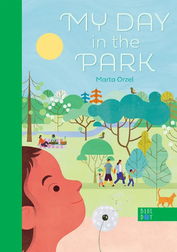 My Day in the Park. Marta Orzel. Trans. by Johanna McCalmont. (2022). Blue Dot. A young child visiting the park with family invites the reader to accompany them. “Let’s see what we find today!” The opening double spread shows an illustrated map of the park with the family near the entrance. Verso pages are filled with lots of small, labeled illustrations of people, things, and activities in the park. Recto pages present large illustrations of related highlights of the day for the child narrator as the family walks along the paths and visits the pond, greenhouse, playground, petting zoo, picnic area, and other places in the park. As the day’s adventure ends, there is another map showing different ways of getting home. The child opts for a favorite mode of transportation, “on my dad’s shoulders.” The book ends with a double spread of items from the day’s visit (“Do you remember. . .”) that is sure to take readers back through the park again and again. Marta Orzel lives in France. (PreK-Gr 2) —NB 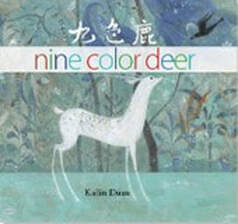 Nine Color Deer. Kailin Duan. Trans. by Jeremy Tiang. (2022). Levine Querido. A long time ago, a mythical deer with fur of nine different colors lived in a forest unknown to humans. Hearing a cry for help, the Nine Color Deer runs through the wilderness and rescues a man drowning in a lake. Asking how he can repay the deer for saving his life, he is told, “All I ask is that you tell no one of my whereabouts.” When the king offers a reward for locating the deer with nine colors in its fur that the queen dreams about, the man breaks his promise and leads the king and his soldiers to the forest. The Nine Color Deer tells the king, “I am the guardian spirit of this place” and warns of the awful fate of the kingdom if it is killed. Wisely, the king orders that no one should ever harm the Nine Color Deer. Kailin Duan’s exquisite artwork for her adaptation of a traditional Buddhist tale was inspired by the one thousand-year-old Mogao Cave paintings in Dunhuang, China. Kailin Duan lives in China. (PreK Up) —CA 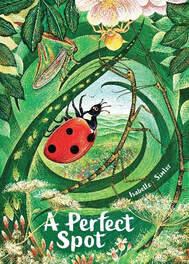 A Perfect Spot. Isabelle Simler. Trans. by Vineet Lal. (2022). Eerdmans. A ladybug searches for somewhere safe to lay her eggs. “In the big, wide world, so lush and green, / a tiny, seven-spotted bug speeds on her way.” She stirs up stick insects that snarl, is attacked by thorn bugs in a rose bush, is shaken and shocked by a katydid in a thicket of trees, escapes from becoming the main course for spiders and mantises in a field of daisies, is pummeled from a tall oak by goat moths and lappet moths, and falls into the most perfect spot among a delectable colony of aphids where she can lay her eggs. Isabelle Simler’s lyrical text and colorful, realistic brush-stroked illustrations invite young readers to observe a variety of arthropods in their natural habitats through the eyes of the little beetle. Back matter includes a double spread about the Seven-Spotted Ladybug and a second one featuring arthropods the ladybug encounters: orchid mantis, thorn bug, crab spider, leaf katydid, stick caterpillar, common stick insect, goat moth, and lappet moth. Isabelle Simler lives in France. (PreK Up) —NB 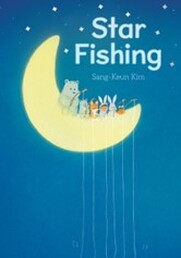 Star Fishing. Sang-Keun Kim. Trans. by Ginger Ly. (2022). Abrams. A young child dressed in a bunny sleeper gazes at the moon. “Is somebody awake?” An answer resounds, “Play with meeeeeee.” Little Rabbit, fishing on the moon with a star as bait, reels in the child who has grabbed onto it. The child asks if they are the only ones awake. With more star fishing, Little Rabbit catches other nonsleepers: Crab, Fox, Big Bear, and Little Bear. They all play among the stars, but worrying that soon Little Rabbit will be lonely when they leave, they use stars to create constellations of Crab, Fox, Big Bear, and Little Bear as reminders of their time together. Little Rabbit cuddles them on a blanket of stars until they drift off to sleep and then sends them home. “It’s the kind of night when everyone is fast asleep.” Sang-Keun Kim’s soothing bedtime fantasy is set against a background of vibrant blue sky filled with tiny sparkling stars and a bright crescent, a magical place to lure children into a good night’s slumber. Sang-Keun Kim lives in South Korea. (PreK-Gr 2) —NB 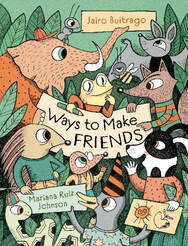 Ways to Make Friends. Jairo Buitrago. Trans. by Elisa Amado. Illus. by Mariana Ruiz Johnson. (2022). Aldana Libros. In this funny and thoughtful picture book with cartoonlike illustrations made with colored pens and digital color, Toad playfully offers ways of making friends. Some suggestions are fairly conventional such as sitting patiently under a tree, waiting until someone comes along who wants to be your friend or saying hi to a shy kid. Other suggestions are wacky such as dressing up like an apple and giving away a pear. Toad ends this how-to guide to making friends with a reminder that after you are tired of making friends just “be yourself and forget everything this book has told you to do” and consider doing some things such as drawing, reading, and daydreaming alone to learn how to be your own best friend. Jairo Buitrago lives in Mexico; Mariana Ruiz Johnson lives in Argentina. (PreK Up) —CA Nancy Brashear is Professor Emeritus of English from Azusa Pacific University, in Azusa, California. Carolyn Angus is former Director of the George G. Stone Center for Children’s Books, Claremont Graduate University, in Claremont, California.
0 Comments
Leave a Reply. |
AuthorsThese reviews are submitted by members of the International Literacy Association's Children's Literature and Reading Special Interest Group (CL/R SIG). Archives
March 2024
Categories
|

 RSS Feed
RSS Feed